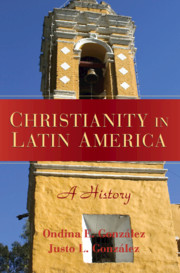Book contents
- Frontmatter
- Contents
- Preface
- Introduction
- 1 Foundations
- 2 The Arrival of Christianity
- 3 The Shaping of the Faith
- 4 Reform Movements
- 5 The Church in Turmoil
- 6 The Church's New Place
- 7 Protestant Immigration
- 8 An Expanding Protestant Presence
- 9 Catholicism after Vatican II
- 10 Pentecostalism and Autochthonous Movements
- 11 By Way of Conclusion
- Some Suggestions for Further Reading
- Sources Referenced
- Index
6 - The Church's New Place
Published online by Cambridge University Press: 05 June 2012
- Frontmatter
- Contents
- Preface
- Introduction
- 1 Foundations
- 2 The Arrival of Christianity
- 3 The Shaping of the Faith
- 4 Reform Movements
- 5 The Church in Turmoil
- 6 The Church's New Place
- 7 Protestant Immigration
- 8 An Expanding Protestant Presence
- 9 Catholicism after Vatican II
- 10 Pentecostalism and Autochthonous Movements
- 11 By Way of Conclusion
- Some Suggestions for Further Reading
- Sources Referenced
- Index
Summary
As we recall from Chapter 5, the wars of independence were by no means the greatest test the church in Latin America would face during the nineteenth century. After suffering the dislocation brought about by independence, the church had to deal with a cultural ethos that no longer saw it as the bastion of truth and right, the guide of morals and ethics, and the powerful protector of the weak. Rather, by the fourth decade of the nineteenth century, many powerful interest groups saw the church throughout Latin America as the chief stumbling block to progress, rife with superstition and greed, and a threat to the future well-being of both state and citizen. As the church struggled to maintain some semblance of its past power and glory, it was caught up in the political struggles between conservatives and liberals, who were vying for control of the new republics.
Even when the church's “friends” (the conservatives) had the upper hand, the church suffered. The penury of the new states was such that they routinely forced loans from religious institutions, including orders, which often could ill afford to provide money to the government. When the church's “foes” (the liberals) had the upper hand, the church's influence and prestige quickly deteriorated. Not only did the church lose land, the responsibility to administer public charity, and legal privileges that its clergy had enjoyed for centuries, but in the case of Mexico, for example, it also became illegal to hold religious services anywhere outside of the church building proper.
- Type
- Chapter
- Information
- Christianity in Latin AmericaA History, pp. 160 - 183Publisher: Cambridge University PressPrint publication year: 2007



